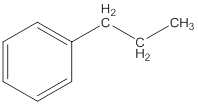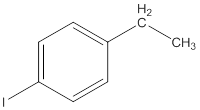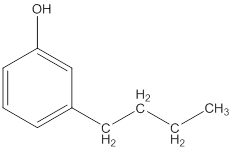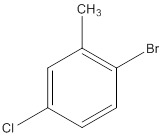
Concept explainers
(a)
Interpretation:
The IUPAC name of the following compound should be determined.

Concept Introduction:
When the mixture of hydrocarbons from natural resources such as coal or petroleum are separated, certain compounds are emerged with pleasant odors and are thus known as
Hydrocarbons with sigma bonds and delocalization of pi electrons between carbon atoms, thus forms a circle is said to be aromatic hydrocarbons.
Rules of naming aromatic compounds are:
- Aromatic compounds are named as a benzene derivative.
- For single substituent, the benzene ring is symmetrical. Thus, all the positions are equivalent.
- For more than one substituent, the benzene ring is not symmetrical. Thus, numbering will be done from one substituent which is attached to ring to other substituent through shorter path. Numbering should be done in a way that the first substituent gets the lowest number.
- In naming, the names of substituents are listed in alphabetical order.
(b)
Interpretation:
The IUPAC name of the following compound should be determined.

Concept Introduction:
When the mixture of hydrocarbons from natural resources such as coal or petroleum are separated, certain compounds are emerged with pleasant odors and are thus known as aromatic hydrocarbons.
Hydrocarbons with sigma bonds and delocalization of pi electrons between carbon atoms, thus forms a circle is said to be aromatic hydrocarbons.
Rules of naming aromatic compounds are:
- Aromatic compounds are named as a benzene derivative.
- For single substituent, the benzene ring is symmetrical. Thus, all the positions are equivalent.
- For more than one substituent, the benzene ring is not symmetrical. Thus, numbering will be done from one substituent which is attached to ring to other substituent through shorter path. Numbering should be done in a way that the first substituent gets the lowest number.
- In naming, the names of substituents are listed in alphabetical order.
(c)
Interpretation:
The IUPAC name of the following compound should be determined.

Concept Introduction:
When the mixture of hydrocarbons from natural resources such as coal or petroleum are separated, certain compounds are emerged with pleasant odors and are thus known as aromatic hydrocarbons.
Hydrocarbons with sigma bonds and delocalization of pi electrons between carbon atoms, thus forms a circle is said to be aromatic hydrocarbons.
Rules of naming aromatic compounds are:
- Aromatic compounds are named as a benzene derivative.
- For single substituent, the benzene ring is symmetrical. Thus, all the positions are equivalent.
- For more than one substituent, the benzene ring is not symmetrical. Thus, numbering will be done from one substituent which is attached to ring to other substituent through shorter path. Numbering should be done in a way that the first substituent gets the lowest number.
- In naming, the names of substituents are listed in alphabetical order.
(d)
Interpretation:
The IUPAC name of the following compound should be determined.

Concept Introduction:
When the mixture of hydrocarbons from natural resources such as coal or petroleum are separated, certain compounds are emerged with pleasant odors and are thus known as aromatic hydrocarbons.
Hydrocarbons with sigma bonds and delocalization of pi electrons between carbon atoms, thus forms a circle is said to be aromatic hydrocarbons.
Rules of naming aromatic compounds are:
- Aromatic compounds are named as a benzene derivative.
- For single substituent, the benzene ring is symmetrical. Thus, all the positions are equivalent.
- For more than one substituent, the benzene ring is not symmetrical. Thus, numbering will be done from one substituent which is attached to ring to other substituent through shorter path. Numbering should be done in a way that the first substituent gets the lowest number.
- In naming, the names of substituents are listed in alphabetical order.
Want to see the full answer?
Check out a sample textbook solution
Chapter 13 Solutions
GENERAL,ORGANIC, & BIOLOGICAL CHEM-ACCES
- 8:17 PM Sun Mar 30 Draw the major product of this reaction. Ignore inorganic byproducts. HSCH2CH2CH2SH, BF3 Probler Drawing Ato Bonds Clarrow_forwardpresented by Mr L How the coprion. (Il Done in no wraction, dew the starting redential) доarrow_forward8:16 PM Sun Mar 30 K Draw the major product of this reaction. Ignore inorganic byproducts. Proble 1. CH3MgBr 2. H3O+ F Drawingarrow_forward
- о но оarrow_forwardName the major organic product of the following action of 4-chloro-4-methyl-1-pentanol in neutral pollution 10+ Now the product. The product has a molecular formula f b. In a singly hain, the starting, material again converts into a secule with the molecular kormula CIO. but with comply Draw the major organic structure inhalationarrow_forwardMacmillan Learning Alcohols can be oxidized by chromic acid derivatives. One such reagent is pyridinium chlorochromate, (C,H,NH*)(CICTO3), commonly known as PCC. Draw the proposed (neutral) intermediate and the organic product in the oxidation of 1-butanol by PCC when carried out in an anhydrous solvent such as CH₂C₁₂. PCC Intermediate OH CH2Cl2 Draw the intermediate. Select Draw Templates More с H Cr о Product Draw the product. Erase Select Draw Templates More H о Erasearrow_forward
- If I have 1-bromopropene, to obtain compound A, I have to add NaOH and another compound. Indicate which compound that would be. A C6H5 CH3arrow_forwardProvide the reagents for the following reactions.arrow_forwardIf I have 1-bromopropene, to obtain compound Z, I have to add two compounds A1 and A2. Indicate which compounds are needed. P(C6H5)3arrow_forward
- Draw the major product of this reaction. Ignore inorganic byproducts. Assume that the water side product is continuously removed to drive the reaction toward products. O CH3CH2NH2, TSOH Select to Draw >arrow_forwardPredict the major organic product(s) for the following reaction.arrow_forwardPredict the major organic product(s) for the following reactions.arrow_forward
